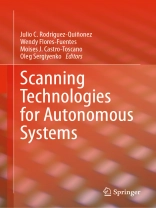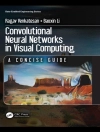This book provides the theory, methodology, and uses of scanning technologies for the application of autonomous systems. The authors provide readers with an understanding of different technologies and methods to perform scanning technologies and their optimal application depending on the kind of autonomous system. Also, the book presents a compilation of original high-quality contributions and research results from worldwide authors on emerging new autonomous systems based on different scanning technologies. This book is a valuable reference for engineering professionals and the scientific community.
İçerik tablosu
Part 1 Scanning Technologies for Navigation and Area Mapping.- Chapter 1 Methodology of Assigning Terrain Objects Images to the Class of Landmarks for Autonomous Mobile Robots.- Chapter 2 Scanning Systems for Environment Perception in Autonomous Navigation.- Chapter 3 Autonomous Visual 3D Mapping of the Ocean Floor by Underwater Robots Equipped with a Single Photo Camera.- Chapter 4 Flexible Multi-Camera Virtual Focal Plane: A Light-Field Dynamic Homography Approach.- Part 2 Scanning Technologies for Medical and Industrial Applications.- Chapter 5 US Scanning Technologies and AI.- Chapter 6 Optical 3D Scanning System in Medical Applications.- Chapter 7 Depth Measurement with a Rotating Camera System for Robotic Applications.- Part 3 Innovative Data Processing Solutions for Scanning Technologies.- Chapter 8 Investigating the Effects of Subsampling Processes to Point Cloud Data on the Generation of 3D Models of Archaeological Monuments.- Chapter 9 Approach to Background Suppression in Scanning Machine Vision Systems.- Chapter 10 Point Cloud Optimization Employing Multisensory Vision.- Part 4 Sensing Applications across Systems, Technological Advancements.- Chapter 11 Person-Centric Sensing in Indoor Environments.- Chapter 12 Machine Vision for Solid Waste Detection.- Chapter 13 Developing a Hardware and Software Complex for Measuring the Three-Dimensional Ice Geometry on Object Surface.
Yazar hakkında
Julio C. Rodríguez-Quiñonez (Senior Member, IEEE). He is currently Full-Time Researcher-Professor in the Engineering Faculty of the Autonomous University of Baja California, and a member of the National Research System Level 1. He is actively involved in the development of an optical scanning prototype within the Applied Physics Department. He serves as a research leader in creating a new stereo vision system prototype and leading research on novel approaches for inertial navigation systems. Over the years, he has taken on the role of thesis director for several Doctoral and Master’s degree students. His contributions have led to the acquisition of three patents related to dynamic triangulation methods and laser scanners. Moreover, he has been an editor of four books and author of ‘Graphical Programming using Lab VIEW: Fundamentals and Advanced Techniques.’ Additionally, he is currently Associate Editor of the IET Image Processing Journal and has served as a Guest Editor for renowned journals such as Measurement (Elsevier), IEEE Sensors Journal, International Journal of Advanced Robotic Systems, and Journal of Sensors. His academic impact is substantial, having written 104 papers indexed in Scopus, resulting in an h-index of 20 and gathering over 1400 citations. Furthermore, he actively contributes as a reviewer for esteemed publications, including Measurement, IEEE Sensors Journal, Optics and Lasers in Engineering, IEEE Transaction on Mechatronics, and Neural Computing and Ap-plications of Springer. His expertise and involvement extend to the international stage, where he has actively participated as a reviewer and Session Chair in various IEEE ISIE conferences held in Turkey (2014), Brazil (2015), USA (2016), UK (2017), Canada (2019), USA (IECON 2018), Portugal (IECON 2019), Netherlands (ISIE 2020), Japan (ISIE 2021), USA (ISIE 2022), and Finland (ISIE 2023). In 2016, he attained the prestigious status of a Senior Member of IEEE, and his collaborative work has earned him the coauthor’s credit for the award-winning ‘Out-standing Paper in the 2017 Emerald Literati Network Awards for Excellence.’ His current research interests encompass automated metrology, stereo vision systems, control systems, robot navigation, and 3D laser scanners, showcasing his unwavering dedication to advancing knowledge in the field of Applied Physics.
Wendy Flores-Fuentes received the bachelor’s degree in electronic engineering from the Autonomous University of Baja California in 2001, the master’s degree in engineering from Technological Institute of Mexicali in 2006, and the Ph.D. degree in science, applied physics, with emphasis on Optoelectronic Scanning Systems for SHM, from Autonomous University of Baja California in June 2014. By now she is the author of 52 journal articles, 23 book chapters and 11 books, 61 proceedings articles in IEEE ISIE 2014-2023, IECON 2014-2023 the World Congress on Engineering and Computer Science (IAENG 2013), IEEE Section Mexico IEEE ROCC2011, and the VII International Conference on Industrial Engineering ARGOS 2014. Recently, she has organized and participated as Chair of Special Session on ‘‘Machine Vision, Control and Navigation’’ at IEEE ISIE 2015-2024 and IECON 2018, 2019, 2022, 2024. She has participated has Guest Editor at Journal of Sensors, The International Journal of Advanced Robotic Systems, IEEE Sensors, Measurement, AIP Advances. She holds 2 patent of Mexico and 1 patent of Ukraine. She has been a reviewer of several articles in Taylor and Fran-cis, IEEE, Elsevier, and EEMJ. Currently, she is a full-time professor at Universidad Autónoma de Baja California, at the Faculty of Engineering. She has been incorporated into CONACYT National Research System in 2015, currently level 2. Her interests include optoelectronics, robotics, artificial intelligence, measurement systems, and machine vision systems.
Moises J. Castro-Toscano was born in March 1989, in Baja California, Mexico. He received the B.S. degree in Instituto Tecnológico de Mexicali, in 2011 and the master’s degree in engineering from Technological Institute of Mexicali in 2014. He received the Ph.D. degree from Baja California Autonomous University, México, in 2019. He is a professor at the Technologic Institute of Mexicali, teaching basic science to engineering students. He is also a professor and a researcher in the Faculty of Engineering, Universidad Autónoma de Baja California, and a member of the National Research System CONACYT. He is involved on the development of navigation application trough inertial navigation systems. He has worked on 7 research articles, and 3 book chapters on different topics as, Stereo Vision Systems, Laser Vision Systems and Inertial Navigation Systems. He has presented its results at different international conference of the IEEE 2017 in Edinburgh, Scotland, IECON 2018 in Washington D.C., USA, ISIE 2020 in Deft, The Netherlands. In addition, he has participated as Session Chair of IEEE IECON 2022 and IEEE ISIE 2023 conferences. His current research interests include inertial navigation, stereo vision systems, control systems, robot navigation and 3D laser scanners.
Oleg Sergiyenko received the B.S., and M.S., degrees in Kharkiv National University of Automobiles and Highways, Kharkiv, Ukraine, in 1991, 1993, respectively. He received the Ph.D. degree in Kharkiv National Polytechnic University on specialty “Tools and methods of non-destructive control” in 1997. He received the DSc. (habit.) degree in Kharkiv National University of Radioelectronics in 2018. He has been an author of 1 book and editor of 8 books, written 31 book chapters, over 190 papers indexed in Scopus and holds 3 patents (of Ukraine and Mexico). Since 1994 till the present time he was represented by his research works in several International Congresses of IEEE, ICROS, SICE, IMEKO in USA, England, Ja-pan, Italy, Austria, Ukraine, Canada, Portugal, Brazil and Mexico. In many of them, he was a Session Chair. He gets the “Best presentation award” on IEEE conferences IECON2014 in Dallas, USA, on IECON2016 in Florence, Italy, ISIE2019 in Vancouver, Canada. He also did receive the Emarald Literati Award of 2017 Outstanding paper for his article published in Industrial Robot: an Inter-national Journal. In December 2004 was invited by Engineering Institute of Baja California Autonomous University for researcher position. He is currently Head of Applied Physics Department of Engineering Institute of Baja California Autonomous University, Mexico, director of several Master’s and Doctorate thesis. He is a full-member (Academician) of Academy of Applied Radioelectronics of Belorussia, Ukraine and Russia. His current research interests include automated metrology, machine vision systems, fast electrical measurements, control systems, robot navigation and 3D laser scanners.












